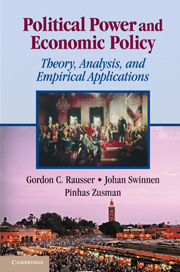Book contents
- Frontmatter
- Contents
- List of Figures
- List of Tables
- Preface
- PART 1 POLITICAL POWER AND ECONOMIC ANALYSIS
- PART 2 IDEOLOGY, PRESCRIPTION, AND POLITICAL POWER COEFFICIENTS
- PART 3 ANALYSIS OF SPECIFIC STRUCTURES
- 10 The Political Economy of Commodity Market Intervention
- 11 The Political Economy of Public Research and Development
- 12 Political-Economic Analysis of Redistributive Policies and Public Good Investments
- 13 Interest Groups, Coalition Breaking, and Productive Policies
- 14 Policy Reform and Compensation
- 15 Political-Economic Analysis of Land Reform
- 16 Political-Economic Analysis of Water Resource Systems
- 17 The Political Economy Lens on Quality and Public Standard Regulations
- 18 Political-Economic Analysis in Transition Economies
- 19 The Power of Bureaucracies: The European Commission and EU Policy Reforms
- PART 4 EMPIRICAL APPLICATIONS OF POLITICAL POWER ESTIMATION
- References
- Index
12 - Political-Economic Analysis of Redistributive Policies and Public Good Investments
Published online by Cambridge University Press: 05 June 2012
- Frontmatter
- Contents
- List of Figures
- List of Tables
- Preface
- PART 1 POLITICAL POWER AND ECONOMIC ANALYSIS
- PART 2 IDEOLOGY, PRESCRIPTION, AND POLITICAL POWER COEFFICIENTS
- PART 3 ANALYSIS OF SPECIFIC STRUCTURES
- 10 The Political Economy of Commodity Market Intervention
- 11 The Political Economy of Public Research and Development
- 12 Political-Economic Analysis of Redistributive Policies and Public Good Investments
- 13 Interest Groups, Coalition Breaking, and Productive Policies
- 14 Policy Reform and Compensation
- 15 Political-Economic Analysis of Land Reform
- 16 Political-Economic Analysis of Water Resource Systems
- 17 The Political Economy Lens on Quality and Public Standard Regulations
- 18 Political-Economic Analysis in Transition Economies
- 19 The Power of Bureaucracies: The European Commission and EU Policy Reforms
- PART 4 EMPIRICAL APPLICATIONS OF POLITICAL POWER ESTIMATION
- References
- Index
Summary
Introduction
Public policies whose intended purpose is to establish allocative efficiency generally have distributional consequences. Similarly, policies designed to be redistributive will also impact on the outcome of policies that are designed to establish allocative efficiency, insofar as they alter incentives and market behavior. The combination of the two types of policies arises in many circumstances. An example widely used for illustration here is the existence of farm income supports combined with politically supported, price-decreasing agricultural research and development (e.g., Rausser and Foster 1990). In the United States, the basic framework for transfer policies has been in place since the 1930s, and these policies have been formed in an environment of technological change, increasing production, a declining farm population, and decreasing food prices. Technological changes, which have been supported by an evolving system of state and federal agricultural research and dissemination since the Hatch Act of 1887 (e.g., Alston et al. 2009; Huffman and Evenson 1984, 2001), have benefited or harmed commodity sectors to differing degrees, and have long been suspected of leaving at least some producers worse off (e.g., the treadmill hypothesis of Cochrane [1979]). Rausser (1982), Rausser and de Gorter (1990), and Gardner (1989) have all emphasized the existence of interactions between agricultural policies that are oriented toward redistributive goals on the one hand and toward allocative efficiencies on the other. Their work has emphasized the potential importance of explicitly recognizing that these two types of policies are, in practice, jointly determined.
- Type
- Chapter
- Information
- Political Power and Economic PolicyTheory, Analysis, and Empirical Applications, pp. 224 - 238Publisher: Cambridge University PressPrint publication year: 2011



